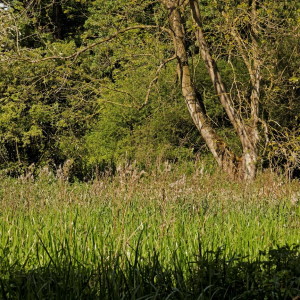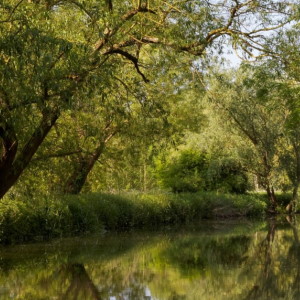Byron’s Pool local nature reserve is a densely wooded area on the north bank of the River Cam. The path around the reserve takes you through the woods, past some small ponds and along the riverbank.
The 4.5 hectare (11 acre) site was part of the Trumpington Hall Estate until we acquired it in 1949. It is named after the poet Lord Byron, who is said to have bathed in a weir pool there while studying at Trinity College. We declared it as a local nature reserve in 2005.
Part of the area used to be a wet meadow, although it rarely floods since the weir was built.
Animals and plants
The woodland comprises a variety of trees including beech, ash, hazel, wych elm, sycamore, horse chestnut and oak, and there is an impressive field maple at the entrance to the woodland.
The reserve attracts a variety of birds throughout the year, including kingfishers, little grebes and grey wagtails on the river, and great spotted woodpeckers, treecreepers and chaffinches in the woods.
Banded demoiselle damselflies patrol the river by day and Daubenton’s bats do so at night. Roach, dace, chubb and brown trout are all common in the river.
In the spring, dog’s mercury, wood anemones, lesser celandine, common violets and cow parsley provide colour to the woodland floor.
In the summer, you’ll see purple and white-letter hairstreak butterflies in the tree canopy, especially around the elm and oak trees.
In the autumn, the fruiting bodies of various fungi emerge, including chicken of the woods and the rare arched earthstar and sandy stiltball.
Our work to manage and improve the reserve
We work to maintain and enhance the reserve’s balance of mature woodland, open glades, riverbanks and meadows.
Sycamore and horse chestnut are non-native species that can dominate the tree canopy and reduce light for the other flora. We are working to prune or remove some of these to help improve the site’s biodiversity.
In the autumn we manage the reserve’s six ponds to maintain the open water to enable common frogs and newts to breed.
We cut the meadow near the car park on a rotational basis, to replicate the grazing regime that would once have been used there.
Access
The paths around the reserve are flat and accessible for wheelchairs.
The reserve has a small, free car park off Grantchester Road, with a height restriction of 6’3” (1.9 metres).
Cycling is not permitted on the reserve.
Facilities
The reserve has platforms for canoeing and fishing.





